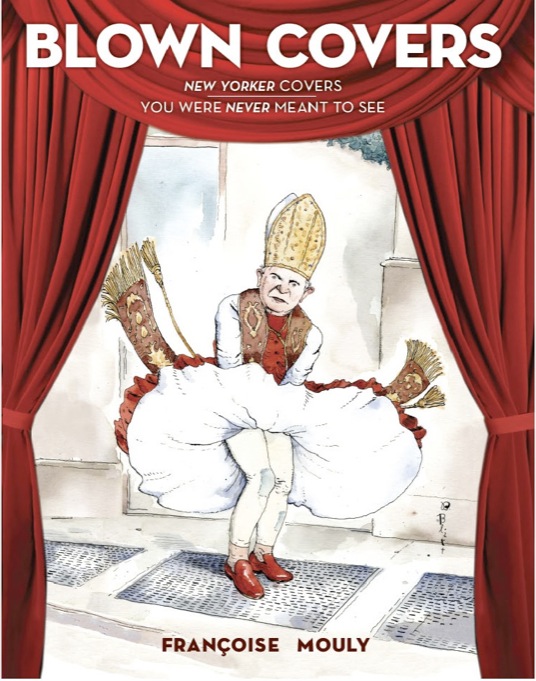Blown Covers: New Yorker Covers You Were Never Meant to See
Author: Françoise Mouly
Publisher: Abrams
ISBN-10: 1-4197-0209-2
ISBN-13: 978-14197-0209-9
In October 2000 Mouly wrote/edited “Covering The New Yorker: Cutting-Edge Covers from a Literary Institution”, a compendium of the best and most influential covers from 75 years of one of the oldest and most widely-read American magazines. Mouly is uniquely positioned to write such a book because she has been the Art Director, the person who has selected what The New Yorker’s cover will be for each issue since 1993.
Now Mouly has written/edited what may be considered its companion volume: “Blown Covers: New Yorker Covers You Were Never Meant to See”. In this book, Mouly describes the editorial process that goes on which results in the magazine covers that are chosen, and shows many of the sketches and finished paintings that are rejected.
For much of its history, The New Yorker had a policy of using decorative and non-topical covers. Mouly and her cadre of artists – Barry Blitt, husband Art Spiegelman, R. Crumb, Harry Bliss, Christoph Niemann, Istvan Banyai, Ian Falconer, and others – have expanded this policy to look for covers that are both decorative and topical without becoming blatant editorial cartoons.
Not all the more than 290 illustrations in this book are unused covers. Often the cover used is shown with several rejected variants. There have been times when the editorial staff has argued between several variants until the press deadline, when one of the variants is chosen just because there is no more time. When the Trade Center was destroyed on September 11, 2001, the initial reaction was to run a solid black cover in memoriam; Art Spiegelman proposed adding the silhouettes of the Twin Towers on it – a black on black image – that was both subtle and memorable.
There are many reasons that one cover is chosen and others are rejected. Sometimes a cover design is approved and painted, and then at the last minute some newsworthy event happens and a topical cover is called for instead, relegating a perfectly good design to the ranks of the unused covers. Sometimes a theme needs an illustration and three or four preliminary sketches are considered before one is chosen. Sometimes an artist has an inspiration that the editorial staff loves but which is judged too open to misinterpretation or too risqué. They are all here.
Blown Covers is broadly arranged by Race & Ethnicity; Sex; Religion; Politics; Celebrities; War & Disasters; and Is Nothing Taboo? Some of the topics included are electorial politics (the Monica Lewinsky affair, Obama vs. Clinton, Obama vs. McCain, Sarah Palin), homosexuality and gay marriage, the “Ground Zero” mosque, child molestation, the O. J. Simpson trial, prejudice against American Muslims, nuclear meltdown in Japan, and American obesity. In addition to The New Yorker’s own covers, sometimes the corresponding covers of other magazines such as Time or Newsweek are shown as examples of how others depicted the same issues. (The New Yorker has the harder job because its covers are always without captions; their point must be made clearly visually only.) There are biographies of thirty contemporary (1993 to the present) cover artists, and an index.
Whether you are interested in the last twenty years of cover art of one of America’s most influential magazines, or you read this for its behind-the-scenes look at how a modern major magazine selects its covers, Blown Covers is fascinating and primarily visual reading.
Disclosure: A free copy of this book was furnished by the publisher for review, but providing a copy did not guarantee a review. This information is provided per the regulations of the Federal Trade Commission.






